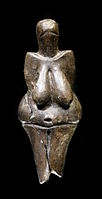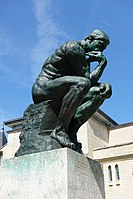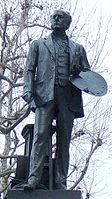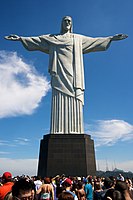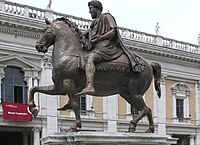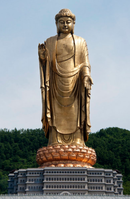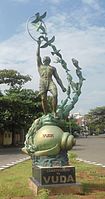Statue
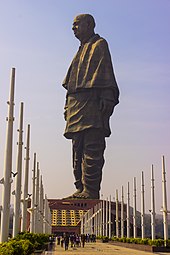
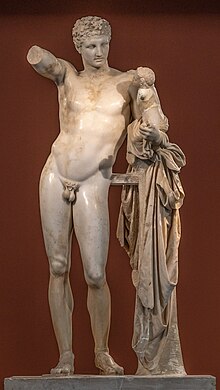
A statue is a free-standing
Statues have been produced in many cultures from
Colors
Ancient statues often show the bare surface of the material of which they are made. For example, many people associate Greek classical art with
Details such as whether the paint was applied in one or two coats, how finely the pigments were ground or exactly which binding medium would have been used in each case—all elements that would affect the appearance of a finished piece—are not known.[2] Richter goes so far as to say of classical Greek sculpture, "All stone sculpture, whether limestone or marble, was painted, either wholly or in part."[4]
Medieval statues were also usually painted, with some still retaining their original pigments. The coloring of statues ceased during the Renaissance, since excavated classical sculptures, which had lost their coloring, became regarded as the best models.
Historical periods
Prehistoric
The
The
The oldest known life-sized statue is Urfa Man found in Turkey which is dated to around 9,000 BC.
Antiquity
Religion
Throughout history, statues have been associated with
The focal point of the
The oldest statue of a deity in Rome was the bronze statue of Ceres in 485 BC.[13][14] The oldest statue in Rome is now the statue of Diana on the Aventine.[15]
Politics
For a successful Greek or Roman politician or businessman (who donated considerable sums to public projects for the honour), having a public statue, preferably in the local
The
Middle Ages
While sculpture generally flourished in European
While
Renaissance
Italian Renaissance sculpture rightly regarded the standing statue as the key form of Roman art, and there was a great revival of statues of both religious and secular figures, to which most of the leading figures contributed, led by Donatello and Michelangelo. The equestrian statue, a great technical challenge, was mastered again, and gradually statue groups.
These trends intensified in
In the late 18th and 19th century there was a growth in public open air statues of public figures on plinths. As well as monarches, politicians, generals, landowners, and eventually artists and writers were commemorated. World War I saw the war memorial, previously uncommon, become very widespread, and these were often statues of generic soldiers.
Modern era
Starting with the work of
The notion that the position of the hooves of horses in equestrian statues indicated the rider's cause of death has been disproved.[18][19]
Gallery
-
Löwenmensch figurine, from Hohlenstein-Stadel, Germany, now in Ulmer Museum, Ulm, Germany, possibly the oldest undisputed statuette. Aurignacianera, 40,000 BC–35,000 BC
-
Two views of the Venus of Hohle Fels figurine, 40,000 BC–35,000 BC (6 cm (2.4 in) tall), one of the earliest known, undisputed examples of a depiction of a human being
-
Venus of Dolní Věstonice, ceramic figurine, 29,000 BC–25,000 BC
-
Venus of Willendorf, one of the oldest known statuettes, Upper Paleolithic, 24,000 BC–22,000 BC
-
Great Sphinx of Giza, c. 2558–2532 BC, the largest monolithic statue in the world, standing 73.5 metres (241 ft) long, 6 metres (20 ft) wide, and 20.22 m (66.34 ft) high. Giza, Egypt.
-
The Charioteer of Delphi, 474 BC, Delphi Archaeological Museum, Greece
-
Vatican Museum
-
Nara, Japan
-
Gommateshvara Bahubali, c. 978–993 AD, 57 feet (17 m) high
-
Moai of Easter Island facing inland, Ahu Tongariki, c. 1250–1500, restored by Chilean archaeologist Claudio Cristino in the 1990s
-
Japan
-
Statue of Liberty (formally Liberty Enlightening the World), New York Harbor, United States, by Frédéric Auguste Bartholdi c. 1886
-
Henry Bain Smith's bronze of Robert Burns, 1892, above Union Terrace Gardens, Aberdeen, Scotland
-
A statue of Tsar Alexander II of Russia, the Grand Duke of Finland, at the Senate Square in Helsinki, Finland, sculpted by Walter Runeberg and Johannes Takanen, 1894
-
Auguste Rodin, The Thinker, 1880–1904
-
Copenhagen, Denmark by Edvard Eriksen1913
-
Statue ofJose Rizal. at the Luneta Park, Philippines c. 1908
-
Standing Nude (1912), by Amedeo Modigliani
-
The statue of Hans Egede, 1921, at Nuuk, Greenland
-
Christ the Redeemer (1931), Rio de Janeiro, Brazil
-
U.S.Arlington, Virginia, by Felix de Weldon1954
-
A closeup of the replica statue of Roman Emperor,Capitoline Museum, Rome
-
Spring Temple Buddha, the world's second tallest statue, overall 128 m (420 ft) in height, completed 2002, China.
-
Lord Murugan Statue, Batu Caves, Malaysia, 140 feet (42.7 m).
-
Balance of Nature statue near VUDA Park, Visakhapatnam
-
Sura and Baya Statue (1989) in center of Surabaya, Indonesia
See also
- Bronze sculpture
- Bust (sculpture)
- Equestrian sculpture
- Figurine
- History of sculpture
- List of statues
- List of tallest statues
- List of statues of Queen Victoria
- List of colossal sculpture in situ
- Mannequin
- Living statue
- Memorial
- Monument
- Statues of Gudea, c. 2100 BC
- Statuette
- Stone carving
- Stone sculpture
- Venus figurines
References
- ^ Collins online dictionary: Colossal "2. (in figure sculpture) approximately twice life-size."; entry in the Getty Art & Architecture Thesaurus® Online
- ^ a b c "Archaeological Institute of America: Carved in Living Color". Archaeology.org. 23 June 2008. Retrieved 30 December 2012.
- ^ "Gods in Color: Painted Sculpture of Classical Antiquity September 22, 2007 Through January 20, 2008, The Arthur M. Sackler Museum". 4 January 2009. Archived from the original on 4 January 2009. Retrieved 30 December 2012.
{{cite web}}: CS1 maint: unfit URL (link) - ^ Richter, Gisela M. A., The Handbook of Greek Art: Architecture, Sculpture, Gems, Coins, Jewellery, Metalwork, Pottery and Vase Painting, Glass, Furniture, Textiles, Paintings and Mosaics, Phaidon Publishers Inc., New York, 1960 p. 46
- ^ Venus of Berekhat Ram (230-700,000 BCE) cork.com
- ^ Rincon, Paul (23 May 2003). "'Oldest sculpture' found in Morocco". BBC News. Retrieved 15 May 2009.
- ^ "Lion man takes pride of place as oldest statue" by Rex Dalton, Nature 425, 7 (4 September 2003) doi:10.1038/425007a also Nature News 4 September 2003
- ^ "Ice Age Lion Man is world's earliest figurative sculpture" by Martin Bailey, The Art Newspaper 31 January 2013
- ^ ""It must be a woman" - The female depictions from Hohle Fels date to 40,000 years ago..." Universität Tübingen. July 22, 2016. Archived from the original on October 11, 2016. Retrieved July 26, 2016.
- ISBN 9771721836page 117
- ISBN 0195102347page 230
- ISBN 0747805202page 28
- ISBN 0786405996page 87
- ISBN 052127365Xpage 19
- ISBN 0521061857page 181
- ^ ISBN 1844846202page 54
- ^ Giedion-Welcker, Carola, ‘’Contemporary Sculpture: An Evolution in Volume and Space, A revised and Enlarged Edition’’, Faber and Faber, London, 1961 pp. X to XX
- ^ Barbara Mikkelson (2 August 2007). "Statue of Limitations". Snopes.com. Retrieved 9 June 2011.
- ^ Cecil Adams (6 October 1989). "In statues, does the number of feet the horse has off the ground indicate the fate of the rider?". The Straight Dope. Chicago Reader. Retrieved 9 June 2011.
External links
Statues.



